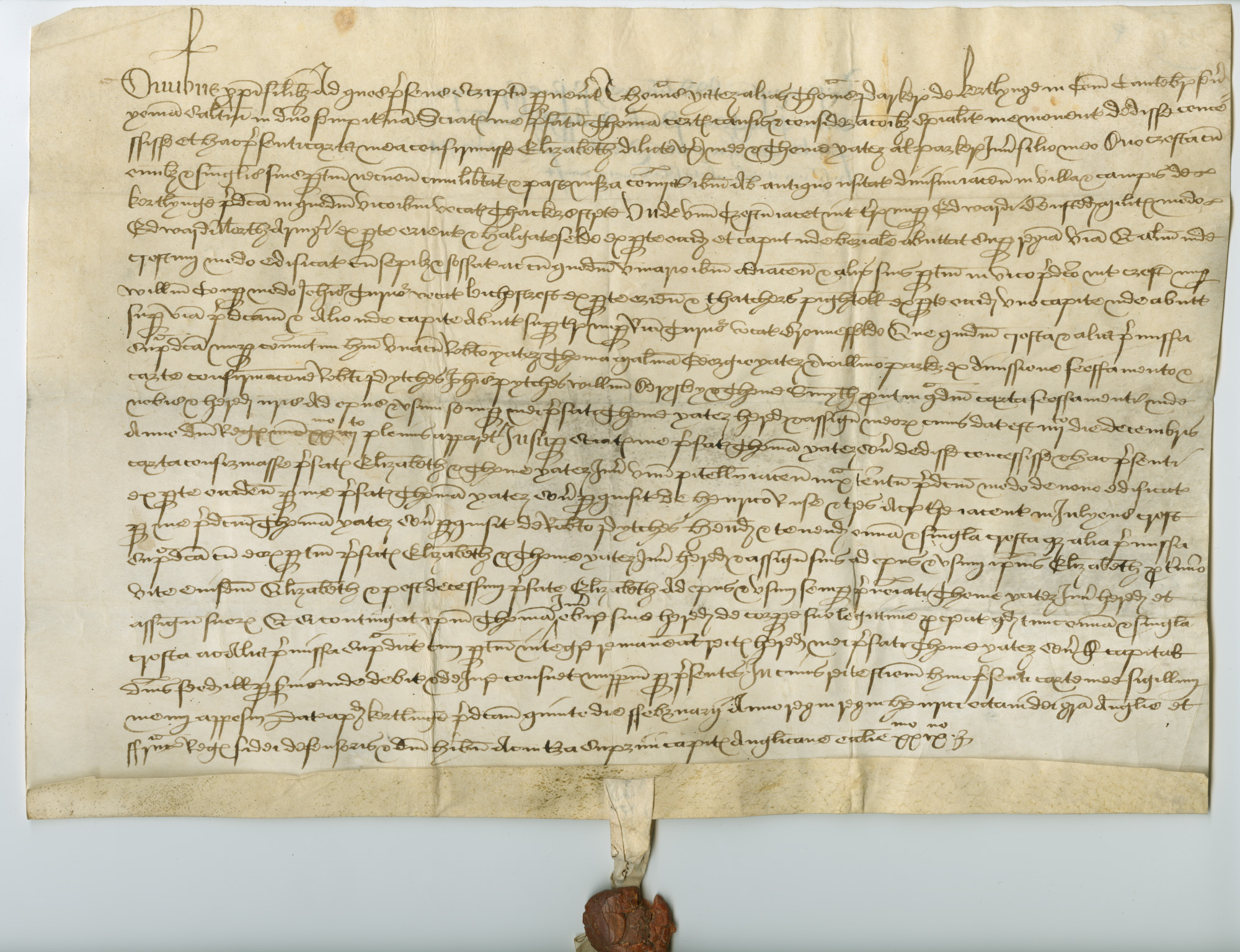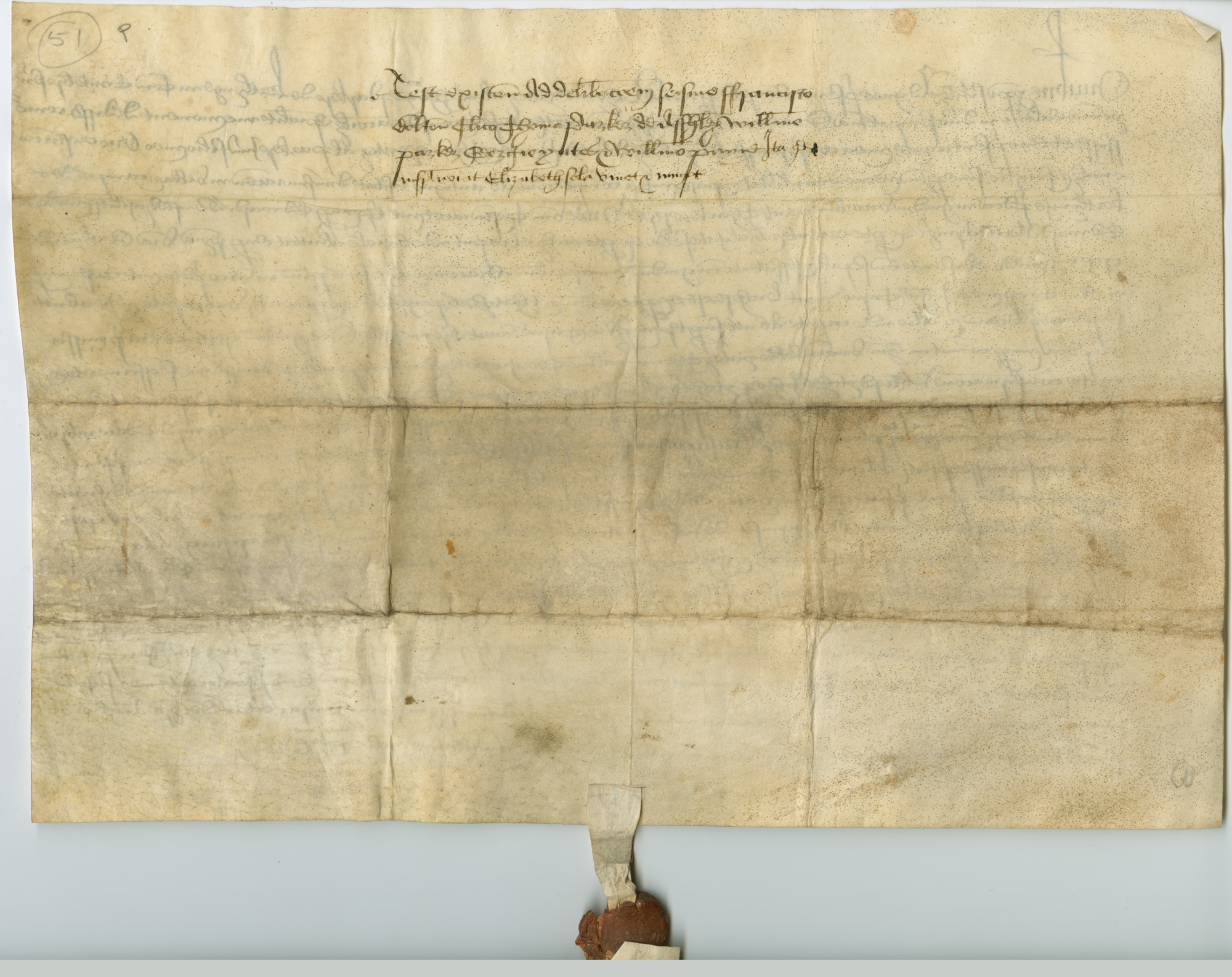I recently spoke about medieval sealing practises. I'm now going to begin a series of posts that focus on seal tags. Seals on letters intended to be broken off as a simple security measure, but also acted as authentication of the sender. Seals affixed to the surface of a page of a public document as authentication of the writer had a tendency to fall off, which was a problem when the seal was the a major means used to prove a document was genuine, which was a concern in a rapidly bureaucratising society making the transition from verbal to written agreements.
Seal tags were a way to attach a seal to documents in a more secure way. That required that the seal was still firmly attached to the document (so that seals couldn't be swapped between documents), but would not be subjected to as bad a stresses as seals attached directly to the page were.
Today's aim is to introduce different varieties of seal tags. In later posts I'll give more examples of these, show you how to construct your own, and explore intricacies of construction.
In earliest form of seal tag, the spare parchment at base of the document was slit to form a long thin strip (like tearing up a minties wrapper), which the wax and seal was applied to. An example is shown below (click on the image to see it large, the links in the text for more provenance details). Like many other examples, there is a second strip of parchment, cut just like the seal tag, with which to tie the document closed when folded up. (which does suggest a possible origin for this method if it can be dated to before seal tags)
Seal tags were a way to attach a seal to documents in a more secure way. That required that the seal was still firmly attached to the document (so that seals couldn't be swapped between documents), but would not be subjected to as bad a stresses as seals attached directly to the page were.
Today's aim is to introduce different varieties of seal tags. In later posts I'll give more examples of these, show you how to construct your own, and explore intricacies of construction.
In earliest form of seal tag, the spare parchment at base of the document was slit to form a long thin strip (like tearing up a minties wrapper), which the wax and seal was applied to. An example is shown below (click on the image to see it large, the links in the text for more provenance details). Like many other examples, there is a second strip of parchment, cut just like the seal tag, with which to tie the document closed when folded up. (which does suggest a possible origin for this method if it can be dated to before seal tags)

Charter with Seal of King Edward the Confessor
Seal in use 1042-1066, charter c1050. Diameter 70mm.
(London British Library, Campbell charter XXI.5)
Of course a long thin strip of parchment wasn’t very durable, and a seal didn’t authenticate a document it was no longer attached to, new ways of sealing were soon developed. This type of sealing was primarily used in the 11th Century, or on documents only expected to need to last a short time.
The most common form of seal tag by the 12th C is a strip of parchment which is a separate piece from the document. Any remaining parchment on the charter is folded up towards the writing so the edge of the parchment sits just below the end of the writing, permitting no space for additional words to be added. This turn-up is generally only a couple of cm wide - If large amounts of parchment remain at the end of writing a scribe could be expected to cut this off for other documents, and smaller portions for use as seal tags. One or three horizontal slits were cut in this doubled parchment, the width of the strip of parchment used as a seal tag. The seal tag was inserted through the slits with ends dangling below the parchment for the seal to attach to. The example below shows both front and rear of the document.
The most common form of seal tag by the 12th C is a strip of parchment which is a separate piece from the document. Any remaining parchment on the charter is folded up towards the writing so the edge of the parchment sits just below the end of the writing, permitting no space for additional words to be added. This turn-up is generally only a couple of cm wide - If large amounts of parchment remain at the end of writing a scribe could be expected to cut this off for other documents, and smaller portions for use as seal tags. One or three horizontal slits were cut in this doubled parchment, the width of the strip of parchment used as a seal tag. The seal tag was inserted through the slits with ends dangling below the parchment for the seal to attach to. The example below shows both front and rear of the document.

 Feoffment by Thomas Yates alias Parker to Elizabeth, his wife, and Thomas Yates, Jr., his son, of a croft in Kirtling, Cambridgeshire.
Feoffment by Thomas Yates alias Parker to Elizabeth, his wife, and Thomas Yates, Jr., his son, of a croft in Kirtling, Cambridgeshire. 1538/39
Tag with red wax seal, depicting a coat-of-arms (cracked, lacking portions).
Tag made from waste material, bearing inscription on inward side.
(McMaster University, British Legal Instruments Collection Ms. 51)
This parchment seal tag remained the most common variety of seal tag throughout the medieval and Renaissance periods. However, for some applications, a fancier document was desired. Just as fancier fonts and illuminated first letters could be used in the text, so could fancy seal tags be used. Such seal tags were normally made of fibres, braided or woven narrow strings. The earliest fibre seal tags I know of date from the late 12th Century, showing this technology developed quickly, although most documents stick with the utilitarian parchment seal tag.
The conceptually simplest forms of fibre seal tags (although often most decorated) are woven strips which replace the parchment seal tag in the same manner. Although the simplest seal tag to attach, these wider tags provide more space for more elaborate textile techniques, as seen in the example below.
The conceptually simplest forms of fibre seal tags (although often most decorated) are woven strips which replace the parchment seal tag in the same manner. Although the simplest seal tag to attach, these wider tags provide more space for more elaborate textile techniques, as seen in the example below.

William de Brus to Durham cathedral priory
c1194x1215. Double faced tabletweaving.
(Durham Dean and Chapter Muniments 4.8 Spec 2)
A form of fibre seal tag which uses a much simpler to make seal tag, but develops it's own method of attachment is the simple "twist" pattern. At it's simplest form the seal tag is a coarse piece of string (as exhibited on the papal bull below), at it's most complicated a narrow piece of braiding or weaving.
One of the most complex forms of seal attachment is the "diamond" seal tag attachment. 2 braids or narrow cords are combined with a plait to make a pretty result, often with contrasting colours. The example below doesn't clearly show details, but you can see the diagnostic diamond pattern. This example appears to be a single coloured braid, but I'll explore the intricacies of the diamond pattern seal tag later.

Charter of Richard I, confirming to Alexander de Barentin, butler to Henry II, all his property fairly purchased or confirmed to him by Henry II.
12th Century
(London, Westminster Abbey Muniments no. 657).
A few much rarer fibre seal tag attachment patterns also exist, and I'll get to a discussion of these much later, when I've gathered more examples. (Please feel free to send me more, good photos of the tags rather than the seal or charter are hard to obtain, and with parchment seal tags the majority of tags, fibre tags are hard to find.)


5 comments:
Not sure if it is what you are looking for, but the National Museum of Lithuania has a few large photos that might help
LNMMB F101-7 (click on the 'text and image' link on the right, might be a plied cord)
http://pergamentai.mch.mii.lt/IstoriniaiLietDok/istoriniailietdok_1en.en.htm
and http://pergamentai.mch.mii.lt/IstoriniaiLietDok/indexlt.lt.htm with another photo of just a seal tag, F101-20 (1519).
There are a few on the Lithuanian-language version that might be more plied cords...
http://pergamentai.mch.mii.lt/pergamentai.lt.htm
F 101-31 (1563), F101-70 is from 1649, F101-99 is 1732.
I have a weird feeling I've told you about those examples before, but I'm not sure.
That's exactly the kind of thing I'm looking for! Thanks!
Remembered another page that might be useful: http://www.lmbric.net/n9/JacobVI/jacobVI.html
And in a moment of 'why didn't I think of this earlier,' the International Association of Book and Paper Conservators has articles discussing manuscripts. They aren't the highest quality images, you can enlarge them a little in the PDF.
eg. http://cool.conservation-us.org/iada/ta95_039.pdf
http://cool.conservation-us.org/iada/ta99_253.pdf
The process of selecting the perfect security seal begins with knowing what purpose the seal will be used for. Specific industries and fields also have unique security concerns, standards and regulations, according to which the characteristics of the security seal will be impacted.
Are you looking for the best garment seal tags? With our garment seal tags you can rest assured that your products will be protected from tampering and counterfeiting. Our garment seal tags are made from high quality material. Contact us today.
Post a Comment